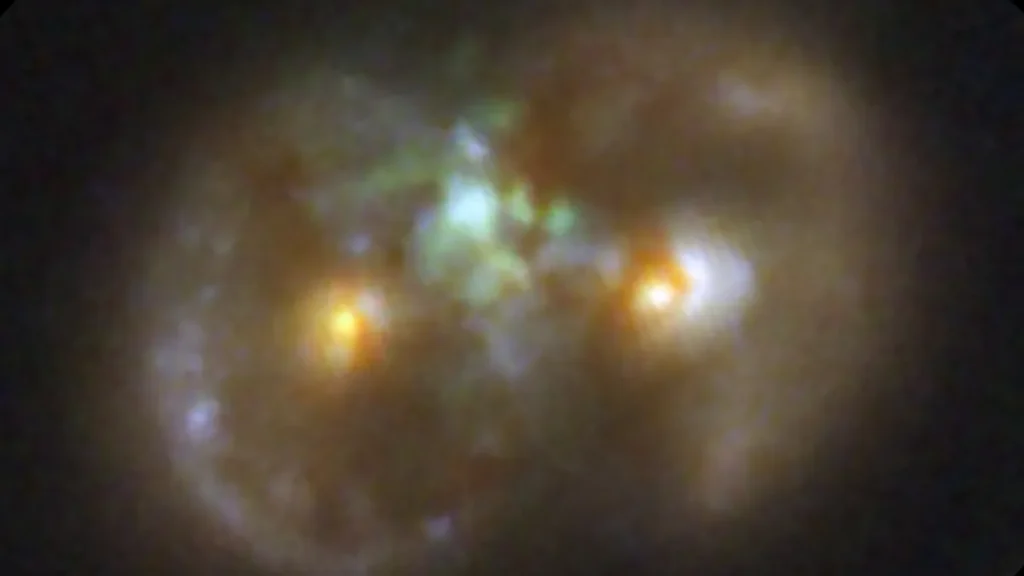Table of Contents

The James Webb Space Telescope (JWST) has once again delivered a mind-bending discovery, challenging our understanding of the universe. This time, it’s a peculiar black hole nestled not in the heart of a galaxy, but between two colliding galaxies within a cosmic entity dubbed the Infinity Galaxy. This extraordinary finding could provide the first observational evidence of a “direct collapse black hole,” a revolutionary concept in astrophysics.
Unraveling the Mystery of the Infinity Galaxy’s Unusual Black Hole
The Infinity Galaxy earned its name due to its striking resemblance to an infinity symbol, a cosmic figure-eight formed by the head-on collision of two disk galaxies. While galactic collisions are not uncommon, what makes the Infinity Galaxy truly unique is the unexpected location of a ravenous black hole. Instead of residing within the core of either colliding galaxy, this black hole sits squarely in the vast gas cloud between them, actively feeding on its surroundings. This has led researchers to ponder: How did it get there?
The Direct Collapse Black Hole Hypothesis: A Game Changer
The prevailing theory for the formation of supermassive black holes involves “light seeds” – stellar-mass black holes born from the demise of massive stars, which then grow through successive mergers and accretion over billions of years. However, JWST observations have presented a cosmic puzzle: supermassive black holes appear to be remarkably common as early as 500 million years after the Big Bang. This timeline is simply too short for the “light seed” model to adequately explain their existence.
Enter the “heavy seed” theory, which proposes a direct collapse black hole. This alternative pathway suggests that a black hole could form directly from the collapse of a massive cloud of gas, bypassing the stellar life cycle entirely. This “direct collapse” would rapidly create a black hole with a mass up to a million times that of our sun, providing the necessary head start to explain the early appearance of supermassive black holes. The challenge, as Yale University researcher and team leader Pieter van Dokkum explains, is that gas clouds typically form stars when they collapse, not black holes. The Infinity Galaxy might just be the smoking gun for this elusive process.
Witnessing the Birth of a Supermassive Black Hole?
The discovery in the Infinity Galaxy strongly supports the direct collapse black hole scenario. Researchers believe that the extreme compression and shockwaves generated during the collision of the two disk galaxies could have created a “dense knot” of gas. This knot, instead of fragmenting into stars, may have undergone a rapid gravitational collapse, leading to the direct birth of a supermassive black hole.
Several pieces of circumstantial evidence from the JWST and other observatories bolster this hypothesis:
- Location, Location, Location: The black hole’s central position between the two galactic nuclei is highly unusual and aligns with the idea of it forming from the compressed gas generated by the collision.
- Ionized Gas: The presence of a vast expanse of ionized hydrogen gas surrounding the black hole in the middle of the Infinity Galaxy suggests an active feeding environment, consistent with a newly formed black hole consuming its birth material.
- Active Growth: Observations from NASA’s Chandra X-ray Observatory and the Very Large Array confirm that this black hole is actively accreting material, further indicating its youth and rapid growth.
Ruling Out Other Explanations for the Infinity Galaxy’s Anomaly
While the evidence points towards a direct collapse black hole, the researchers also considered alternative explanations:
- Runaway Black Hole: Could it be a black hole ejected from a galaxy and merely passing through? This is unlikely, as a runaway black hole would be expected to have a significantly different velocity from the surrounding gas in the Infinity Galaxy.
- Third Galaxy: Is it the central black hole of a faint dwarf galaxy co-located with the collision? This is also improbable, as dwarf galaxies typically do not host such massive black holes.
To definitively test their hypothesis, the team plans to precisely measure the velocity of the gas and the black hole. If their velocities are closely matched (within approximately 30 miles per second or 50 kilometers per second), it would be incredibly difficult to argue against the black hole having formed directly from that gas. Preliminary results are already showing a strong correlation, with the black hole beautifully centered within the velocity distribution of the surrounding gas.
A Trio of Black Holes in the Infinity Galaxy
Adding to the intrigue, the researchers made another surprising discovery: both of the colliding galaxies within the Infinity Galaxy also harbor their own active supermassive black holes! This means the Infinity Galaxy is a cosmic playground for black holes, boasting three confirmed active supermassive black holes – two at the heart of each galaxy, and the enigmatic one in between.
While a definitive statement awaits further analysis, the JWST data from the Infinity Galaxy significantly strengthens the case for the direct collapse black hole pathway, offering a potential solution to the long-standing mystery of early supermassive black hole formation. This unprecedented observation provides a thrilling glimpse into the violent and creative processes shaping our universe. The team will continue to delve into the data, eager to uncover more secrets hidden within the Infinity Galaxy.
1 thought on “Infinity Galaxy’s Black Hole Mystery: JWST Uncovers a Cosmic Anomaly”
Comments are closed.